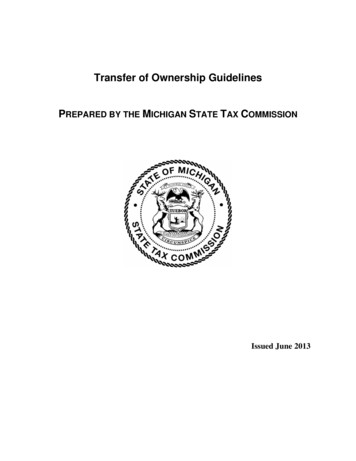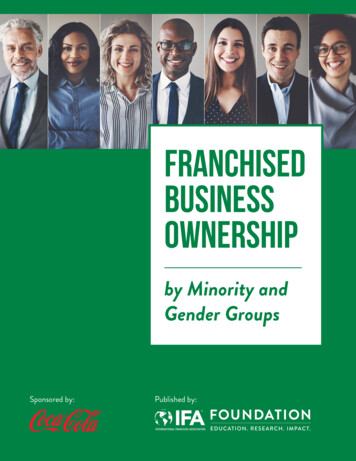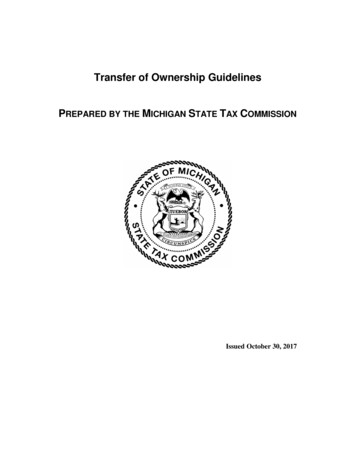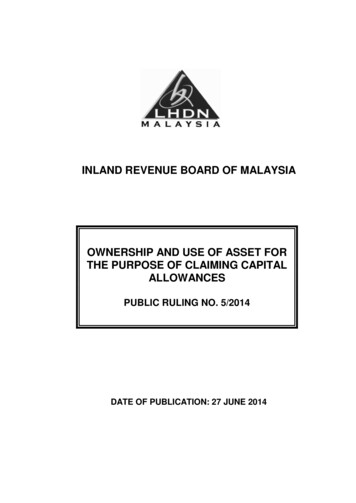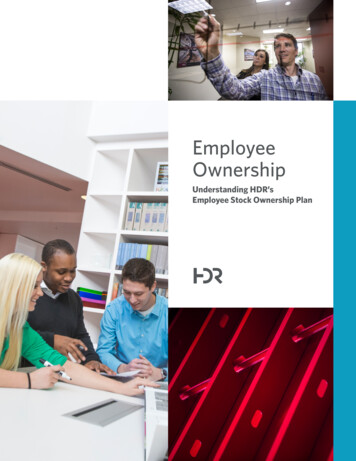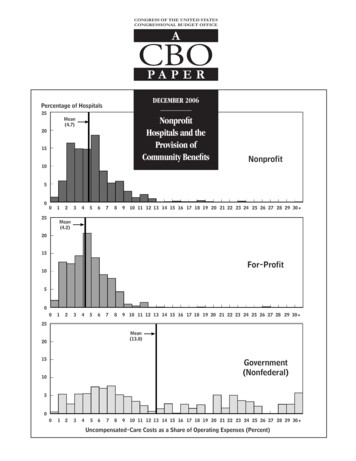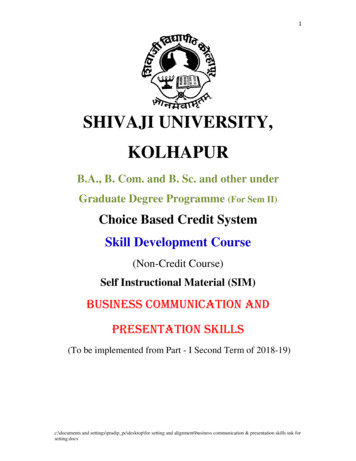
Transcription
Introduction to Product Ownership AnalysisDriving the creation and delivery of high value products.
Introduction to ProductOwnership Analysis
International Institute of Business Analysis, Toronto, Ontario, Canada. 2020 International Institute of Business Analysis. All rights reserved.This document is provided to the business analysis community for educational purposes. IIBA does not warrant thatit is suitable for any other purpose and makes no expressed or implied warranty of any kind and assumes noresponsibility for errors or omissions. No liability is assumed for incidental or consequential damages in connectionwith or arising out of the use of the information contained herein.IIBA , the IIBA logo, BABOK and Business Analysis Body of Knowledge are registered trademarks owned byInternational Institute of Business Analysis. CBAP is a registered certification mark owned by International Instituteof Business Analysis. Certified Business Analysis Professional, ECBA, EEP, and the EEP logo are trademarks owned byInternational Institute of Business AnalysisNo challenge to the status or ownership of these or any other trademarked terms contained herein is intended by theInternational Institute of Business Analysis.Any inquiries regarding this publication, requests for usage rights for the material included herein, or correctionsshould be sent by email to info@iiba.org.
Table of ContentsChapter 1: Purpose of this Document1.11.2IIBA Introduction to Product Ownership Analysis 1Who can use this Introduction? 2Chapter 2: What is Product Ownership Analysis?2.12.22.32.42.5Defining the POA Domain 3The Product Owner Role and POA 4Product Owner and Product Manager 6Applying POA to Agile Planning 7POA throughout the Product Lifecycle 9Chapter 3: POA Context3.13.23.33.43.53.63.7Objectives of Value Delivery 11POA Responsibilities 11POA Delivery Approaches and Framework 13Key Outcomes 14Stakeholders 15Challenges 16Critical Success Factors 18Chapter 4: Integrating Business Analysis and POA4.14.24.34.44.54.6Business Analysis Discipline 19POA Focus 19Integrating BA and POA 20Applying the Core Concepts of Business Analysis 21Agile Business Analysis 21Business Analysis Techniques for POA 23Chapter 5: The POA Framework5.1Seven Domains of the POA Framework 25i
Table of ContentsChapter 6: The IIBA Guide to Product Ownership AnalysisAppendix: Contributors 29ii
1Purpose of this DocumentThis document introduces the business analysis community to the ProductOwnership Analysis (POA) domain. As more organizations transition fromproject-centric models to a product-centric view, it is important tounderstand how product ownership is evolving and what it takes to deliversuccessful products. This Introduction is followed by the "IIBA Guide toProduct Ownership Analysis”.PROJECT - CENTRICPRODUCT - CENTRICProduct ManagerProduct OwnerBusiness AnalystProduct Owner AnalysisProject ManagerProduct OwnerBusiness Analyst1.1IIBA Introduction to Product Ownership AnalysisIIBA Introduction to Product Ownership Analysis assists teams create anddeliver exceptional products and services for their customers andstakeholders with proven practices cultivated from: traditional product ownership, agile business analysis, human-centered design approaches, business model development, lean startup, design sprint methods, and lean product development.1
Who can use this Introduction?1.2Purpose of this DocumentWho can use this Introduction?This Introduction benefits practitioners who: work as product owners, support product owners in their work, execute product ownership related work, are transitioning to a product ownership related role, and are considering product ownership as a career path option.2
2What is Product Ownership Analysis?2.1Defining the POA DomainThe POA domain requires a clear understanding of the intersection of productdevelopment with modern agile practices.2.1.1Product DevelopmentThe biggest risk of product developmentis to create a great product that nobody wants.Products can captivate customers and propel an organization to greatersuccess, or they can result in wasted investments that hobble an organizationfor years. A product's success depends on customers' perception of how wellit solves their problems and addresses their needs. To ensure a consistentflow of customer value, many organizations have embraced agile productdevelopment practices.2.1.2Product Owners using AgileThe business analysis community is experiencing two significant productrelated trends: Organizations embracing a product-centric view of work, and Organizations rapidly adopting agile product development practices.Effective product ownership activities are critical and pivotal to productsuccess. An increasingly large number of Business Analysis (BA)Professionals are: supporting product owners, acting as proxy product owners, or being asked to take on product ownership roles or responsibilities.The product owner role, as originally defined and popularized with Scrum,took responsibility for maximizing value delivery. However, many believe thatproduct ownership becomes more effective and impactful as a team ownedresponsibility. POA builds on this philosophy to deliver both strategic andtactical contributions towards solving customer problems through buildinggreat products while maximizing value created. In this expanded view,product ownership activities help craft value delivery to meet both3
The Product Owner Role and POAWhat is Product Ownership Analysis?operational product requirements and meet the organization's strategicgoals.The fundamental goal of product ownership doesn't change - it's still aboutmaximizing value delivered by the team. However, the increasingly complexand dynamic nature of this work goes beyond managing the product backlog,which is part of the reason why the entire team needs to take responsibilityfor product ownership.2.1.3Product Ownership Analysis (POA)Product Ownership Analysis is a researched and studied discipline, with aset of practices, processes, and procedures to create successful outcomes.POA involves the use of specific techniques and the development of keycompetencies that support practitioners as they navigate the complexchallenges associated with creating successful products.POA provides Product Owners, Proxy Product Owners, and Team Memberswith: The necessary framework, Tools, Techniques, Approaches, and Foundational agile values.2.2The Product Owner Role and POAAs defined by the Agile Extension to the BABOK Guide:"The Product Owner is the role on the team thatrepresents the interests of all stakeholders, defines the features of the product,and prioritizes the product backlog."— the Agile Extension to the BABOK Guide.Product success goes beyond the product owner providing daily guidance tothe delivery team. Additional responsibilities are required to ensure the valuebeing created by the team is aligned with: Customer needs, Organizational goals, Industry changes, and The dynamic marketplace.Product success requires expanding industry understanding of the productowner's traditional role to encompass both tactical and strategic aspects ofproduct development. Effective POA is demanding, complex and multi4
What is Product Ownership Analysis?The Product Owner Role and POAdimensional with several key responsibilities to support the delivery team. Itrequires a multifaceted, enhanced understanding of the product owner rolewhich includes acting as the: Customer advocate, Team vanguard, Design partner, Product strategist, Learning champion, and Value mensional role of the Product Owner5
Product Owner and Product Manager2.3What is Product Ownership Analysis?Product Owner and Product ManagerConfusion about the product owner role and its relationship to other roles hasproven problematic for organizations, (e.g., responsibilities split across theproduct owner and the product manager). Organizations adopting agileapproaches often struggle with how best to distribute responsibilities.Organizational context heavily influences whether both the product ownerand product manager roles exist, and the allocation of responsibilities. Thegenerally accepted differences between the two roles are:Product OwnerProduct ManagerProduct Focus(responsibilities) Responsible for detailedproduct delivery, Ensures ongoing productvalue is aligned withcustomer and businessneeds, Responsible for MVP, Maintains a detailed viewof the product, Involved in strategic andtactical product work, Backlog managementincluding epics, userstories, and definition ofdone, and Responsible fortraceability. Maintains the productvision, Sets the long-termproduct strategy andproduct roadmap, Focuses on the entireproduct life cycle, with anemphasis on ensuringalignment betweenproduct value and marketneeds, and Contributes to managingthe product portfolio andthe total value delivered.Stakeholders(audience) Focuses on allstakeholders that will beinvolved or impacted byproduct delivery,particularly customers,and Works closely with allimplementation teammembers, includingtechnical experts. Focuses primarily on thecustomer and the market,and Responsible for productacceptance and revenuegeneration.6
What is Product Ownership Analysis?Expertise(competency)Applying POA to Agile PlanningProduct OwnerProduct Manager Has domain knowledge,combined with businessexpertise and strongtechnical experience inensuring product deliveryas per the vision, Expert knowledge of: Customer Data Product Good knowledge ofimplementationmethodologies andvarious productdevelopment approaches. Develops strong domainknowledge based onmarket analysis andcustomer needs, Expert knowledge of: Customer Data Business Market & Industry Good knowledge ofimplementationmethodologies andvarious productdevelopment approaches.2.4Applying POA to Agile Planning2.4.1Agile PlanningThe Agile Extension defines three planning horizons: Strategy, Initiative, andDelivery. Together they act as a framework to shift perspective between longterm strategic decision-making and the immediate needs of customers. Eachplanning horizon describes the longevity and impact of decisions andfeedback loops to allow practitioners to synchronize activities and managebusiness imperatives. At a strategic level, customer expectations and needsfeed into: Strategy, Target markets, Product portfolio decisions, Product roadmaps, and Product lifecycle investments.Changes at the strategic level funnel downward to product features, includingnew additions and adaptations, and require evolving: Release plans, Product metrics, and Intermediate goals.Changes are reflected in daily decisions that optimize the delivery process.7
Applying POA to Agile Planning2.4.2What is Product Ownership Analysis?POA PlanningPOA is applied at each of the three levels of planning (Strategy, Initiative, andDelivery) to continuously align the product value being created with customerexpectations and organization goals.Agile Planning HorizonsStrategy levelInitiative levelDelivery levelOrganization Mission &VisionProduct VisionIteration PlanBusiness StrategyProduct RoadmapDaily Work PlanInitiativesRelease PlanAt each level: Feedback is gathered, Lessons learned are conducted, and Informed decisions are made.OrganizationMission & VisonOrganizations workhard to develop avision that isaligned with theirmission. Use theMission & Vision todrive strategic goals& objectives.BusinessStrategyUse the BusinessStrategy to executework to meet goals.Initiatives areKFGPVKƒGF VQ FGNKXGT desired results.InitiativesInitiatives are longerterm work to meetaspects of thebusiness strategy.ProductVisionProducts & servicesKFGPVKƒGF YKVJKP initiatives needKPFKXKFWCNN[ FGƒPGF outcomes.ProductRoadmapA roadmapdescribes how toachieve the productvision & engagesstakeholders.ReleasePlanA high-level tacticalRNCP VJCV KFGPVKƒGU major features to bedelivered for theproduct being built.IterationPlan FGPVKƒGU HGCVWTGU for near timeconstruction& delivery.Daily WorkPlanUsed by teams tobuild featuresKFGPVKƒGF KP VJG Iteration 8LEARNDECIDELEARNDECIDE
What is Product Ownership Analysis?POA throughout the Product LifecycleProduct ownership analysis is applied throughout the product lifecycle.Product Sales2.5POA throughout the Product ERetire?TimeEffective analysis throughout each product lifecycle stage allows the team toensure: Fast feedback is used to evolve the product, and Ongoing customer value is delivered.POA practices applied at each product life cycle stage:StagePOA PracticesIncubation Provide ways to identify and understand customer needs,gaps and opportunities using customer-centric designapproaches. Improve the quality of product ideas. Evolves the understanding of customers and the marketplaceto solidify a strong product vision.Build Help develop a strong value proposition for customers. Assist in targeting specific market segments with a suitablevalue proposition for each segment. Help to solidify implementation plans, using relevantstrategies for specific market segments and product launchstrategies.9
POA throughout the Product LifecycleWhat is Product Ownership Analysis?StagePOA PracticesLaunch Help fine-tune mechanisms to capture product metrics andcustomer feedback. Provide opportunities to tweak product features based oninitial launch success. Manage organizational expectations based on marketintroduction. Implement additional product launch tactics. Plan and devise additional tactics for product growth andmarket penetration based on initial results.Growth Tweak the product to deliver additional customer value. Search for additional tactics based on market feedback toincrease product adoption and utility. Identify ways to evolve the product organically. Implement and tests product growth strategies to identifythe best ones. Plan and execute implementation tactics to grow productacceptance and adoption.Maturity Sustain the product by continuously adapting to changingcustomer expectations. Apply various strategies to improve, redesign, and optimizethe overall customer experience to extend the life of theproduct. Plan to revive the product for additional growth. Plan to retire the product, if appropriate.Decline Codify learnings and successes so they can be reused infuture products. Implement plans to retire the product.10
3POA Context3.1Objectives of Value DeliveryPOA derives value for organizations and customers through the creation anddelivery of high value products. The fundamental objectives that supportvalue delivery include: Gain Deep Understanding of Customers: Identify customer problems, Understand their severity, and Identify opportunities to delight customers. Engage Key Stakeholders: Engage the team, customers and any otherstakeholders that impact the success of the product. Design Solutions for Impact: Design the solution that maximizes valuedelivery within given business context and constraints (business andtechnical) while balancing value, feasibility, and strategic considerations. Create and Deliver Product Value: Deliver value through incrementalbuild of product features. Learn and Adapt: Analyze value delivery based on regular customerfeedback, supplemented with quantitative analysis. Optimize Product Value: Make timely, informed decisions to removeimpediments and continually improve the team's ability to develop theevolving product.3.2POA ResponsibilitiesThe POA scope of responsibilities vary depending on: the product, the organizational context, and whether there is a single product team or multiple teams workingtogether on larger product initiatives.These responsibilities may be allocated to: a single product practitioner, distributed among multiple practitioners on a single team, or shared across multiple product delivery teams.11
POA Responsibilities3.2.1POA ContextSingle Practitioner on a TeamA single practitioner is responsible for product ownership related activities,(e.g., the product owner), and manages all associated activities including: Building a shared understanding of the product vision amongstakeholders, Defining value delivery in prioritized product increments, Deciding on the solution that will satisfy customer and business needswithin given constraints, and Maximizing the value delivered by the team.3.2.2Multiple Practitioners on a Single TeamResponsibility for product ownership related activities is shared with variousmembers of a team who contribute as needed. This subscribes to the"product ownership is a team responsibility" philosophy. All the productownership related work needs to be done but the work is shared across teammembers and ownership of the outcomes is shared.3.2.3POA across Multiple TeamsMultiple teams may be involved depending on product size, complexity, ordistribution of product resources. POA activities include coordinating productincrements and their delivery. Each team takes responsibility for one or morecomponents, which are then integrated into the overall product increment.Collaboration and communication across teams add complexity andchallenges, including: Holistically understanding needs and requirements across all teams, Ensuring priorities are understood with all teams working to meet sharedgoals, and Collectively assessing value delivery to ensure teams are coordinatingcreation of the next product increment.12
POA Context3.3POA Delivery Approaches and FrameworkPOA Delivery Approaches and FrameworkEffective POA requires finding the right balance between strategic andtactical considerations. In addition to customer value being created, theproduct must align with, and meet, the organizations strategic objectives. TheBABOK Guide describes numerous techniques that can be used to ensurealignment including the benchmarking and market analysis. The StrategyAnalysis knowledge area can be used to drive and support important productownership related decisions to: Analyze current state, Define future state, Assess risks, and Define change strategy.Daily POA activities involve planning and executing tasks that correspond tothe initiative and delivery horizons including: Vertically or horizontally slicing products into smaller increments, Prioritizing product increments by business value, and Designing, building, and delivering product increments frequently.Many of the supporting approaches and techniques are described in the"Agile Extension to the BABOK Guide". They can help drive effective productownership activities leading to: High levels of collaboration, Just-in-time documentation, Regular assessments of value, Frequent product releases, and Rapid learning and ability to adapt.Frameworks include:FrameworkDescriptionDevOpsA set of practices that integrate and automate theprocesses, procedures, and tools between softwaredevelopment (Dev) and information technologyoperations (Ops) to deliver more reliable productincrements at a higher velocity.Feature DrivenDevelopment (FDD)Focuses on client-valued functionality to develop workingsoftware. All planning, design, and development areperformed based on feature sets.13
Key Outcomes3.4POA ContextFrameworkDescriptionExtremeProgramming (XP)Development activities codified for maximum efficiencyincluding: pair- programming, test-driven development, and other craftsmanship approaches to technical practices.Scaled AgileFramework (SAFe )Implementing agile practices to scale at an enterpriselevel, highlighting the individual roles, teams, activities, and artifacts.ScrumA series of fixed length iterations called sprints. At theend of each sprint, the team produces a working productincrement of a high enough quality that could bedelivered to a customer.KanbanAn Agile framework replicating "just-in-time"manufacturing concepts of Kanban for productdevelopment. It utilizes Kanban boards and cards tovisually represent work items and manage the flow ofwork.Key OutcomesMost agile product delivery approaches measure success through productoutcomes with value created iteratively and delivered to customers in smallincrements. Each product increment must be in usable condition and can bedelivered to customers independently or as part of a group of productincrements.3.4.1POA OutcomesWhile focusing on overall product delivery, POA develops outcomes for: Shared understanding of strategic product vision and priorities, Selecting a solution option for design and build, Maintaining a prioritized product backlog, and Supporting the team's build activities.3.4.2Team OutputsThe team collaborates with stakeholders to produce outputs that supportproduct build activities, including: Elaborated backlog items,14
POA ContextStakeholders Acceptance criteria, Definition of done, Use scenarios, Examples and screen mockups, Data and process models, Business rules, and Screen mock-ups.3.5StakeholdersStakeholders are either impacted by the product or involved in productdelivery. Stakeholders can be either internal or external to the organization.A stakeholder is a group or an individual with a relationship tothe change, the need, or the solution. — the BABOK GuideStakeholders depend on organization, product, and market considerations.Typical stakeholders for product development include: Customers: the recipients of the value delivered by the product,particularly where there may be contractual or moral rights that need tobe met Key Stakeholders: business leaders responsible for an organization'sstrategic decisions, regulatory agencies, if applicable, and those involvedin the product because they: Invested in, Receive some benefit from, Depend on, or Are interested in. Supporting Stakeholders: provide support during Product build activities, or Product delivery, (e.g., product marketing or subject matter experts). Delivery Team: responsible for designing and building a viable, high valuesolution, or product, that meets various stakeholders' needs. Competitors: a rich source of information for the delivery team (e.g., tobuild and position product for maximum impact).Effective POA practices focus on engaging stakeholders throughout theinitiative, and as product increments are created and delivered. The BABOK 15
ChallengesPOA ContextGuide includes more information on Stakeholder Engagement to achieve thedesired business outcomes.3.6ChallengesChange-driven approaches and the need for POA arose from the gaps andfailures of plan-driven methodologies. Organizations are seeing a trend in theadoption of change-driven approaches due to their benefits and successrates.PLAN - DRIVEN3.6.1CHANGE - DRIVENPOA ResponsibilitiesEffective POA takes on a diverse set of responsibilities, which requires arange of skills and competencies including: Thinking strategically and tactically, Addressing business needs and technical constraints, and Engaging stakeholders, including Customers, Delivery team, and Management team.These responsibilities can be overwhelming in a fast-paced, complex, anddynamic environment. Regardless of organizational context or roles used,POA practices can help support the team's success.3.6.2Role clarity.1 Product Owner versus Product ManagerOrganizations often struggle with determining whether they need productmanagers or product owners. Where both roles exist, the allocation ofresponsibilities amongst these roles can be a challenge. Both roles performproduct ownership analysis to varying degrees, but accountability is different(see 2.3 Product Owner and Product Manager).Unclear role definitions: Cause confusion,16
POA ContextChallenges Make inefficient use of team member skills, Reduce morale, and Often negatively impact value delivery by the team.2 Product Owner versus Project ManagerThe product owner guides the team through the delivery process and mayfacilitate discussions and identify work, but they do not manage people or theprocess. Using POA practices enhances the product owner's ability to meetthose responsibilities. Project managers that want to successfully transitionto product-centric organizations need to abandon top-down, manage theproject plan, leadership approaches.3 Effectively using BA ProfessionalsMany organizations experience benefits in transitioning BA Professionals tosupport product ownership either as Product owners, Proxy product owners, or Supporting the team.This can be a winning strategy. A senior BA Professional can use theirunderlying competencies developed in analysis work effectively for productownership related work. The BA professional's experience needs to bealigned with the work that best supports the product team's success, (e.g., asenior BA Professional as product owner; a less experienced BA Professionalto support the team).4 Trust and Decision-making AuthorityIt is often challenging for team members to understand who has the authorityto make decisions. This creates issues when team members seek guidanceand direction. Effective POA enables the team to make informed decisions,and decision-makers to make sound decisions. POA facilitates objectivedecision-making and reduces subjectivity.3.6.3Agile Considerations.1 Agile Mindset for POAFor effective POA, the team needs to embrace and exhibit agile principles andpractices in all their work and execute them daily.For example, one of the core values of agile is responding to change overfollowing a plan, which requires flexibility and adaptability.17
Critical Success FactorsPOA Context.2 Agile Practices Without the MindsetAgile practices that are misunderstood or incorrectly applied can lead to"starts and stops" and failed product delivery. Teams often adopt one or twoagile practices (e.g., "daily standups"), and think that is being agile. Agileapproaches encourage creating product increments in short work cycles,whereas, following plans and over managing work: Stifles creativity, Minimizes customer feedback, and Becomes an obstacle to learning and adapting.Effective POA requires adopting the right balance of agile and traditionalpractices for the context of the product development effort.See the "Agile Extension to the BABOK Guide" for the seven principles ofagile business analysis, the agile core values and the agile mindset.3.7Critical Success FactorsSuccessful POA is influenced by: Sharing a clear and engaging product vision to build understanding for allstakeholders, Getting support from key stakeholders in understanding business contextand solution viability, Making effective decisions to prioritize needs and value delivery, Ensuring transparency all the time through the Product Backlog, Validating value throughout product build activities, Willing to quickly learn and adapt, and Developing a supportive and transparent relationship within the productteam(s).18
4Integrating Business Analysis andPOA"The practice of enabling change in an enterprise by defining needs andrecommending solutions that deliver value to stakeholders". — BABOK Guide4.1Business Analysis DisciplineThe business analysis discipline defines and recommends solutions by using: Powerful analysis tools, Techniques, Proven practices, Approaches, and Competencies.Solutions may include: Improving efficiencies through automation, Introducing new processes, Improving business practices or environment, and Introducing/adapting software solutions.Business analysis is a broad discipline with principles and practices that canbe used in various contexts. It can be extremely powerful when applied toproduct ownership challenges. Various business analysis tasks, knowledgeareas, practices, techniques, and underlying competencies, described in theBABOK Guide can be considered building blocks for POA.4.2POA FocusProduct ownership analysis focuses on developing products and services thatbest address customers' needs.Sound application of business analysis techniques leads to robust decisionmaking and effective problem-solving, and when applied in POA results in: Creating high-value products for customers, Increasing productivity in delivering product increments, and Identifying effective viable solutions that meet long-term needs.19
Integrating Business Analysis and Product Ownership4.3Integrating Business Analysis and POAIntegrating Business Analysis and ALYSISBusiness Analysis focus: Translating "Why" to "How" Managing requirements Modelling & communicatingrequirements Enabling change through solutionsProduct Ownership focus: Determining "Why" and "What" Product vision and roadmap Managing shippable value Customer advocacyProduct Ownership Analysis Stakeholder engagement Process understanding Problem understanding Decision making Managing feedback and communication20PRODUCTOWNERSHIP
Integrating Business Analysis and POA4.4Applying the Core Concepts of Business AnalysisApplying the Core Concepts of Business AnalysisThe Business Analysis Core Concept Model (BACCM ) is a conceptualframework for business analysis that can be applied to POA. The BACCM iscomprised of six terms that have a common meaning to business analysispractitioners: Changes: deliver products inanticipation of Changing needs,Changes Market trends, Regulations, orNeedsSolutionsStakeholdersContexts Disruptive technologies. Solutions: identify viablesolutions that make a lastingimpact by delivering long termvalue. Context: ensure ongoingproduct value byunderstanding:Value Changing context, Applying learnings, and Using learnings toimprove productdecisions and team performance. Value: evolve the product to maximize value delivered through Learning wha
As defined by the Agile Extension to the BABOK Guide: "The Product Owner is the role on the team that represents the interests of all stakeholde rs, defines the features of the product, and prioritizes the product backlog." — the Agile Extension to the BABOK Guide. Product success goes beyond the product owner providing daily guidance to
